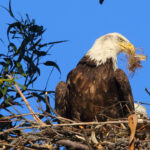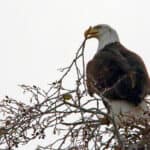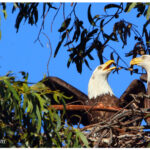Bird detection system to be installed on Altamont Pass turbines
Golden eagles, some of the largest birds in North America with a wingspan of up to seven feet, face deadly situations when they fly in the territory of wind turbines at Altamont Pass. These wind farms generate important renewable, pollution-free electricity, so hopefully the settlement of a recent lawsuit will cut down on the number of golden eagle deaths caused by the turbines. In the settlement, one wind turbine company at Altamont Pass has agreed to install new equipment designed to shut the turbines off when a golden eagle flies toward them.



Altamont Pass’s first turbines were erected on a private ranch in the 1980s, when no one thought about the effects of turbines on raptors and regulators didn’t know that Altamont was home to many golden eagles. Now about 60 golden eagles are killed each year in Alameda County, most of them at the Altamont Pass wind farm. More than 200 golden eagles live in the Altamont Pass area. A seven-year U.S. Geological Survey study consistently found 21 pairs defending territory within the wind farm. In both 2020 and 2021, more than a quarter of those pairs successfully raised one or more chicks. If they survive, those chicks are apt to look for nesting territory near Altamont Pass when they are four years old.


In 2021, Golden Gate Audubon Society, Mt Diablo Audubon Society, Ohlone Audubon Society, and Santa Clara Valley Audubon Society joined the National Audubon Society in a lawsuit that challenged Alameda County’s management of the wind farm at Altamont Pass. While no one wanted to stop the electric power generation, the organizations did want fewer birds to be killed.
The settlement reached as a result of that lawsuit requires the company that operates many of the older, smaller turbines to replace them with fewer, taller, more efficient turbines and to install a new bird detection system, IdentiFlight, to stop the turbines when a golden eagle flies close. The company must also search for golden eagle carcasses and report the number of birds killed. In addition, the company must pay two penalties if the turbines kill more than an average of four birds per year: $30,000 per eagle death over four to the East Bay Regional Park District for golden eagle conservation, and whatever penalty the U.S. Fish and Wildlife Service (USFWS) determines.


Glenn Phillips, executive director of Golden Gate Audubon Society described how IdentiFlight works: “Using high-performance video imaging and AI, the system identifies approaching raptors and stops the turbines before the raptor enters the rotor-swept area.” While it is new, IdentiFlight was installed at a wind farm in Wyoming as part of a settlement of a lawsuit over the killing of eagles there. Researchers found that about 80% fewer eagles were killed by turbines where IdentiFlight was used than at a similar site nearby without the IdentiFlight system.

“We did not have this new technology 20 years ago when we were examining wind development and bird strikes in the Altamont area,” said Ed Vine, retired Program Manager for the California Institute for Energy and Environment (CIEE), who was involved in reviewing the scientific research work for the California Energy Commission at Altamont Pass. “So I am very glad that this is available and I hope its use will be more widespread.” It should be noted that regulatory agencies did take many steps to try to avoid killing birds, but none were successful.

This was not the first time conservation organizations sued to stop the wind farm from killing golden eagles. An earlier lawsuit led to the creation of the Technical Advisory Committee and installation of taller turbines, but eagle deaths continued and the county started approving changes requested by the companies without considering the committee’s recommendations. Hopefully, these new changes will actually reduce the number of eagles killed.
We all benefit from energy generated by the wind turbines at Altamont Pass, and we all should hope that this set of changes in the approval and operation of the turbines results in a significant reduction in the number of golden eagles killed each year by the turbines.
Marjorie Powell moved to Alameda from the East Coast in 2014. A member of Golden Gate Audubon Society, she serves on its Alameda Conservation Committee, the Friends of the Alameda Wildlife Reserve, and tries to go birding frequently.




